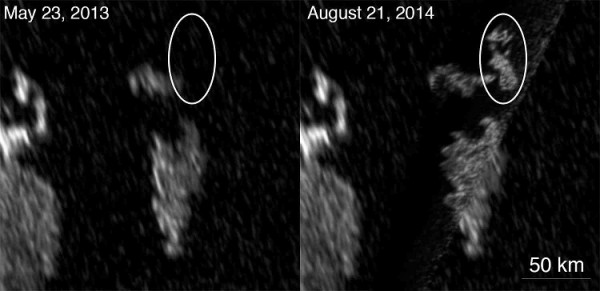Cassini Discovers "Magic Islands" on Saturn's Moon, Titan
| Ana Verayo | | Nov 12, 2014 06:00 AM EST |
(Photo : NASA/JPL-Caltech/ASI/Cornell) Two Synthetic Aperture Radar (SAR) images from NASA's Cassini spacecraft show a bright feature in Kraken Mare, the largest hydrocarbon sea on Saturn's moon, Titan.
NASA's Cassini probe discovered two new islands floating on Titan, one of Saturn's moons.
These mysterious islands appear and then disappear. The first of these islands was discovered last year. Scientists are calling them "magic islands".
These magic islands were discovered by Cassini on Titan's largest sea, the Kraken Mare, during a flyby last August 21. The space probe is examining and observing the sea to learn its composition and how it works.
Like Us on Facebook
Titan is the only known satellite in the solar system with seas and lakes similar to Earth. These bodies of liquid, however, consist of liquid methane and ethane.
Although researchers discovered the first mystery "magic island" in another Titan sea last year, it was picked up by only one instrument aboard Cassini. These two new magic islands were both seen by Cassini's Visible and Infrared Mapping Spectrometer (VIMS). Data from VIMS will enable scientists to study the islands on two wavelengths.
Scientists believe these floating islands are probably waves or floating debris. If they're not waves, they could be something more solid, said Jason Soderblom, a researcher on the Cassini project. It's definite they're objects on the surface of the ocean.
Using Cassini's radar, the research team attempted to explore the depths of the Kraken Mare which they found has a depth ranging from 66 feet to 115 feet. In January 2015, the probe will attempt to measure the depth of Titan's third largest ocean, the Punga Mare.
Cassini will bid farewell to Kraken Mare when it departs Titan. The probe will make a last stop at Ligeia Mare in January 2015 before the mission ends. This is where the first magic island was found.
Cassini has been studying and exploring Titan since 2004.
TagsCassini Reveals "Magic Islands" on Saturn's Moon, TItan, NASA, cassini, Saturn, TItan, cassini magic islands saturn moon titan
©2015 Chinatopix All rights reserved. Do not reproduce without permission
EDITOR'S PICKS
-

Did the Trump administration just announce plans for a trade war with ‘hostile’ China and Russia?
-

US Senate passes Taiwan travel bill slammed by China
-

As Yan Sihong’s family grieves, here are other Chinese students who went missing abroad. Some have never been found
-

Beijing blasts Western critics who ‘smear China’ with the term sharp power
-

China Envoy Seeks to Defuse Tensions With U.S. as a Trade War Brews
-

Singapore's Deputy PM Provides Bitcoin Vote of Confidence Amid China's Blanket Bans
-

China warns investors over risks in overseas virtual currency trading
-

Chinese government most trustworthy: survey
-

Kashima Antlers On Course For Back-To-Back Titles
MOST POPULAR
LATEST NEWS
Zhou Yongkang: China's Former Security Chief Sentenced to Life in Prison

China's former Chief of the Ministry of Public Security, Zhou Yongkang, has been given a life sentence after he was found guilty of abusing his office, bribery and deliberately ... Full Article
TRENDING STORY

China Pork Prices Expected to Stabilize As The Supplies Recover

Elephone P9000 Smartphone is now on Sale on Amazon India

There's a Big Chance Cliffhangers Won't Still Be Resolved When Grey's Anatomy Season 13 Returns

Supreme Court Ruled on Samsung vs Apple Dispute for Patent Infringement

Microsoft Surface Pro 5 Rumors and Release Date: What is the Latest?










